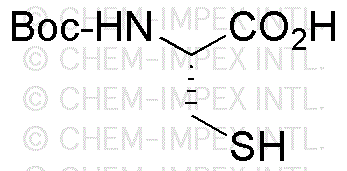Boc-L-cysteine is widely utilized in research focused on:
- Peptide Synthesis: This compound serves as a protecting group for cysteine residues during peptide synthesis, allowing for the selective modification of other amino acids without affecting the cysteine. This is crucial in creating complex peptides for pharmaceuticals.
- Drug Development: Its role in the development of cysteine-containing drugs is significant, particularly in designing inhibitors for various diseases. Researchers leverage its properties to enhance drug stability and efficacy.
- Bioconjugation: Boc-L-cysteine is used in bioconjugation processes, where it helps attach biomolecules to surfaces or other molecules, facilitating the development of targeted therapies and diagnostics in the medical field.
- Antioxidant Research: This compound is studied for its antioxidant properties, contributing to research aimed at combating oxidative stress-related diseases. Its unique structure allows for the exploration of new antioxidant mechanisms.
- Protein Engineering: In protein engineering, Boc-L-cysteine is utilized to introduce thiol groups into proteins, enabling further modifications and enhancing the functionality of engineered proteins in various applications, including biotechnology.
General Information
Properties
Safety and Regulations
Applications
Boc-L-cysteine is widely utilized in research focused on:
- Peptide Synthesis: This compound serves as a protecting group for cysteine residues during peptide synthesis, allowing for the selective modification of other amino acids without affecting the cysteine. This is crucial in creating complex peptides for pharmaceuticals.
- Drug Development: Its role in the development of cysteine-containing drugs is significant, particularly in designing inhibitors for various diseases. Researchers leverage its properties to enhance drug stability and efficacy.
- Bioconjugation: Boc-L-cysteine is used in bioconjugation processes, where it helps attach biomolecules to surfaces or other molecules, facilitating the development of targeted therapies and diagnostics in the medical field.
- Antioxidant Research: This compound is studied for its antioxidant properties, contributing to research aimed at combating oxidative stress-related diseases. Its unique structure allows for the exploration of new antioxidant mechanisms.
- Protein Engineering: In protein engineering, Boc-L-cysteine is utilized to introduce thiol groups into proteins, enabling further modifications and enhancing the functionality of engineered proteins in various applications, including biotechnology.
Documents
Safety Data Sheets (SDS)
The SDS provides comprehensive safety information on handling, storage, and disposal of the product.
Product Specification (PS)
The PS provides a comprehensive breakdown of the product’s properties, including chemical composition, physical state, purity, and storage requirements. It also details acceptable quality ranges and the product's intended applications.
Certificates of Analysis (COA)
Search for Certificates of Analysis (COA) by entering the products Lot Number. Lot and Batch Numbers can be found on a product’s label following the words ‘Lot’ or ‘Batch’.
*Catalog Number
*Lot Number
Certificates Of Origin (COO)
This COO confirms the country where the product was manufactured, and also details the materials and components used in it and whether it is derived from natural, synthetic, or other specific sources. This certificate may be required for customs, trade, and regulatory compliance.
*Catalog Number
*Lot Number
Safety Data Sheets (SDS)
The SDS provides comprehensive safety information on handling, storage, and disposal of the product.
DownloadProduct Specification (PS)
The PS provides a comprehensive breakdown of the product’s properties, including chemical composition, physical state, purity, and storage requirements. It also details acceptable quality ranges and the product's intended applications.
DownloadCertificates of Analysis (COA)
Search for Certificates of Analysis (COA) by entering the products Lot Number. Lot and Batch Numbers can be found on a product’s label following the words ‘Lot’ or ‘Batch’.
*Catalog Number
*Lot Number
Certificates Of Origin (COO)
This COO confirms the country where the product was manufactured, and also details the materials and components used in it and whether it is derived from natural, synthetic, or other specific sources. This certificate may be required for customs, trade, and regulatory compliance.


